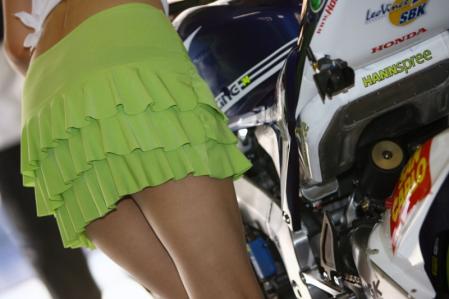|
|
Girl, Chinese MotoGP Race 2007
|
Overview
A Road Racing World Championship Grand Prix was first organized by the Fédération Internationale de Motocyclisme (FIM) in 1949. The commercial rights are owned by Dorna Sports. Teams are represented by the International Road Racing Teams Association (IRTA) and manufacturers by the Motorcycle Sport Manufacturers Association (MSMA). Rules and changes to regulations are decided between the four entities, with Dorna casting a tie-breaking vote. In cases of technical modifications, the MSMA can unilaterally enact or veto changes by unanimous vote among its members. These 4 entities compose the Grand Prix Commission.
There have traditionally been several races at each event for various classes of motorcycles, based on engine size, and one class for sidecars. Classes for 50cc, 80cc, 125cc, 250cc, 350cc, and 500cc solo machines have existed over time, and 350cc and 500cc sidecars. Up through the 1950s and most of the 1960s, four-stroke engines dominated all classes. In part this was due to rules which allowed a multiplicity of cylinders (thus smaller pistons, thus higher revs) and a multiplicity of gears (thus narrower power bands, thus higher states of tune). In the 1960s, two-stroke engines began to take root in the smaller classes. In 1969 the FIM, citing high development costs for non-works teams, brought in new rules restricting all classes to six gears and most to two cylinders (four cylinders in the case of the 350cc and 500cc classes). This led to a mass walk-out of the sport by the previously highly successful Honda Suzuki and Yamaha manufacturer teams, skewing the results tables for the next several years, with MV Agusta effectively the only works team left in the sport until Yamaha (1973) and Suzuki (1974) returned with new two-stroke designs. By this time, two-strokes completely eclipsed the four-strokes in all classes. In 1979, Honda on its return to GP racing made an attempt to return the four-stroke to the top class with the NR500, but this project failed, and in 1983, even Honda was winning with a two-stroke 500. The 50cc class was replaced by an 80cc class, then the class was dropped entirely in the 1990s, after being dominated primarily by Spanish and Italian makes. The 350cc class vanished in the 1980s. Sidecars were dropped from World Championship events in the 1990s (Superside), reducing the field to 125s, 250s, and 500s.
MotoGP, the premier class of GP motorcycle racing, has changed dramatically in recent years. From the mid-1970s through 2001, the top class of GP racing allowed 500cc with a maximum of 4 cylinders, regardless of whether the engine was a two-stroke or four-stroke. Consequently, all machines were two-strokes, due to the greater power output for a given engine capacity. Some two- and three-cylinder two-stroke 500s were seen, but though they had a minimum-weight advantage under the rules, typically attained higher corner speed and could qualify well, they lacked the power of the four-cylinder machines. In 2002, rule changes were introduced to facilitate the phasing out of the two strokes, probably influenced by what was then seen as a lack of relevance: the last mass-produced 500cc 2-stroke model had not been available to the public for some 15 years. The rules permitted manufacturers to choose between running two-strokes engines (500cc or less) or four-strokes (990cc or less). Manufacturers were also permitted to employ their choice of engine configuration. Despite the significantly increased costs involved in running the new four-stroke machinery, given their extra 490cc capacity advantage, the four-strokes were soon able to dominate their two-stroke rivals. As a result, by 2003 no two-stroke machines remained in the MotoGP field. The 125cc and 250cc classes still consist exclusively of two-stroke machines. In 2007, the MotoGP class had its maximum engine displacement capacity reduced to 800cc for a minimum of 5 years. For the 2012 season the capacity will be increased again to 1000cc.
|
|









